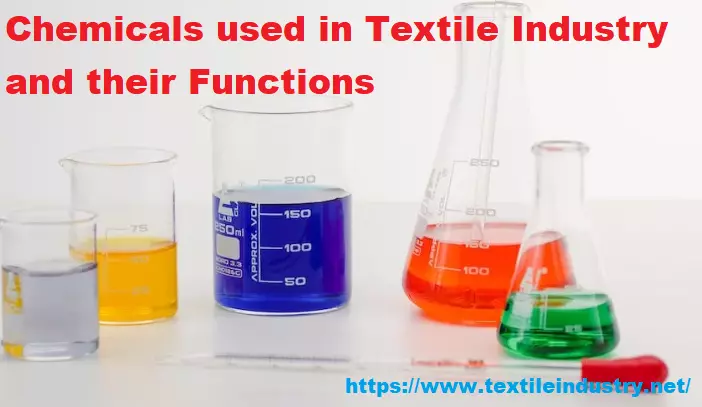After making the fabric, it is grey in color. Along with the fabric, there are various types of dust, wax, and foreign materials which have to be removed during the fabric dyeing and finishing process. Different types of chemicals and techniques are used in the fabric dyeing and finishing section to give the fabric color, GSM, hand feel, shrinkage, thickness, etc. as per the customer’s requirement. Below are the names and uses of the 20 most important different Chemicals used in the Textile Dyeing industry and their functions.
Many chemicals are used in Textile wet processes like Pre-treatment and dyeing processes. Every chemical has a specific function and role to play in these chemical processes. Every chemical agent and its quantity in the chemical solution are equally important. Here are discussing functions of chemicals that are used in the textile wet process.

List of Chemicals used in Textile Dyeing and their Functions
Hydrogen peroxide: This is a very basic chemical used in the textile wet process. Removes dust from fabric. Removes wax, and removes natural gray color.H2O2 was first introduced in 1888 but commercially used from 1930.
2 H2O2→ 2H2O +2[O]
In the early stage, it was thought that [O] is responsible for peroxide activities. But further research has shown that
H2O2 H+→ +HO2-
HO2- + Color→ -OH– + Oxidized Color
Stabilizer: It is used to stabilize the reaction of peroxidase. Stabilizers act as a gel and entrapped ions. As they entrapped ions it increases the lifetime of ions and helps to react gradually rather than strick up. It prevents the tailing effect. Stabilizer chemicals are Stabilizer PSLT, kappazon H53, STAB, and Tinoclarite CBB.
Soda: As we know at lower PH exhaustion of Dye takes place. But at high PH it stops migration and starts reactions. So Soda and other alkalis are used to increase the PH level of the solution. Soda also acts as an activator. In an aqueous medium Cation of Soda neutralize the surface potential of fiber and the reaction starts. Assist in color fixation by covalent bond formations.
Sequestering agent: Deactivates metal ions by forming legends. Reduces water hardness.
Waiting Agent: Reduces surface tension of the liquids. Improves rapid waiting properties.
Detergent: It is one kind of surface-active agent. Used as a wetting agent. Used as a cleaning agent. Generally, detergents’ PH is above or around 10. So at high PH, some dyes are susceptible to reaction. So, it causes problems in wash fastness. Jintex-GD, Felosan RGN, and Jintex-GS.
Anticreasing agent: Used to eliminate the tendency of the fabric to fold. These chemicals react with terminal reactive groups of fiber that’s why they cannot further make bonds with other terminal groups. If they are allowed to form bonds with other terminal groups of the same fiber, it causes a crease. So, it prevents creasing in this way. It is a lubrication-type chemical.
Antifoaming agent: Used to prevent the formation of foam in liqueurs. Not used in dye baths.
Leveling agent: Used to maintain uniform distribution of chemicals in the fabric. Ensure even shade.
Reduction agent: It is used to remove excess dyes from the fabric.
Soaping agent: It is a type of liquid soap. It is used while washing the fabric to remove excess color from the fabric.
Fixing agent: This agent is used to fix the color of the fabric. Fixing agents are Sandofix EC, Tinofix-ECO, Protefix-DPE-568, Jinfix –SR, Optifix-EC.
Enzymes: Enzymes are biocatalysts. In specific conditions, it acts on substrates and decomposes them. With careful control, it is possible to remove hairiness from the fabric. Makes the fabric soft. The enzyme removes peeling. Enzyme chemicals are Tinozyme 44L, Rzyme 1000, Avozyme CL PLUS, Enzyme-B50.
Softener: Makes the fabric soft. Increases surface luster, Increases hand feel. Increases flexibility. Cetasaft CS, Resomine Supper, Acelon, Resosoft –XCL, Silicon (For Finishing).
Hydrogen: It is a type of reducing agent. It is used to remove the color from the fabric.
Salt: Helps bring dyes from the dye bath to the fabric surface. It neutralizes the fiber surface. Removes Zeta potential. Salt increase fabric shade percentage. Maintain PH and exhaustion of Dyes.
Acetic acid: It is one of the most widely used acids in the textile industry. It neutralizes the fabric. Controls PH.
Sodium acetate: It is a kind of buffering agent. Keeps PH stable during polyester dyeing.
Dispersing agent: DPA prevents Dye agglomeration. Keep Dyes in mono molecular form and better spread into the liquor. It is used for uniform penetration of dyes on all sides of polyester fabric.
Protonic Chemicals: It is used to remove line marks from fabric.
Here is the end functions of different Chemicals used in the Textile Dyeing industry article, put comments here below if any.
- You may love to read: Basic Anatomy of Reactive dye
- Application of Foam Technology in Textile Industry
- Desizing: Mechanism, Processes, Types in Textile
- Scouring Process in Textile Industry
